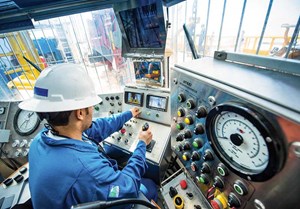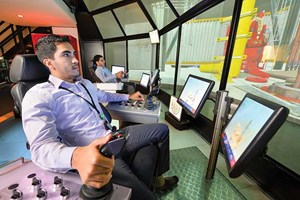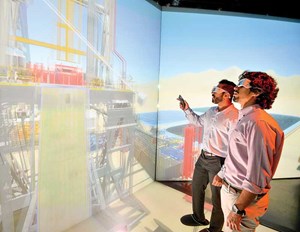Technology investment is key to the future of energy

There are many lessons to be learned from the global coronavirus outbreak, but one in particular stands out: technology is key. It is a mantra adopted by the oil and gas industry for some time—one that has been amplified by the spread and impact of Covid-19. After all, it is because of technology that our engineers and geologists are able to control real-time drilling operations from their own homes, reducing the risk of virus transmission. Companies in all sectors that have not deployed technology in the workplace successfully could be among those most affected by the fallout.
Yet, as large sections of the global economy faced shutdowns while the world searched for Covid-19 solutions, let’s remember that fuel stations were able to continue pumping petrol. Mail and shopping were still being delivered by vehicles running on fuel-powered engines. More importantly, hospitals continued to function, with the power running, and ambulances went on transporting patients, even as other basic services were suspended.
Such situations remind us of the things we take for granted, including access to energy. In many parts of the world, people are accustomed to a reliable and constant energy supply. The need for a resilient energy network comes into sharp focus during times of crisis, when power supplies and fuel deliveries are playing a critical role in our ability to power homes, healthcare services and essential supply chains across the globe.

Investment pays off. Few things in this life are guaranteed, but it is the energy industry’s extensive investment in technology over many decades that allows us to minimize interruptions, no matter what is happening in the world, Fig. 1. Developing these technologies is only possible by working with the best and brightest minds, who are able to apply a combination of science, technical skill and foresight to create new, innovative solutions to ensure security of energy supply.
At Aramco, much of this work is carried out in our global network of research and technology centers in Saudi Arabia, Asia, Europe and the U.S, Fig. 2. These centers focus on the type of technological breakthroughs that enabled Aramco to smoothly ramp up production to record levels in April, achieving output of 12.3 MMbopd. This would constitute a significant milestone in any context, but when you consider it was achieved under the extraordinary circumstances of coronavirus, it is even more remarkable. The same technology allowed us to scale back production in line with an agreement reached by OPEC, Russia and other G20 nations.
Big Data and AI. The adoption of a complex suite of analytics allows our engineers to harness the power of Big Data and Artificial Intelligence (AI) to monitor and manage enormous oil fields and gas reservoirs remotely, minimizing the need for personal travel and face-to-face meetings. We can access data to study and review hundreds of production scenarios, which factor in market demand, crude price, reserves depletion and crude mix for thousands of wells. Engineers have access to real-time well information from their desktops, no matter where they are located, and machine-learning is used to optimize reliable and safe drilling operations. Intelligent field equipment can even predict and mitigate potential equipment failures while controlling the flow of crude and gas with minimum human interference.

In-house innovation. The large appetite for new breakthroughs is illustrated by the fact that several of Aramco’s technologies were developed in-house, capitalizing on fourth industrial revolution (4IR) advancements to maximize upstream operations, Fig. 3. One example is DrillCAM, a system that allows engineers to predict ahead of drill bits for real-time decision-making. It reduces drilling uncertainties and enables well placement in high-quality reservoir zones.
The Mission-Driven Artificial Lift Intelligent System (MIDAS) is a machine-learning technology that enables engineers to automatically monitor Electric Submersible Pumps (ESPs), detecting and diagnosing failures ahead of time. This improves performance and reduces production deferrals that result from shutdowns. SpiceRack, an autonomous system that utilizes robotization for seafloor seismic acquisition at depths of up to 3,000 m, was developed by Aramco in collaboration with Seabed Geosolutions. This 4IR technology increases productivity and reduces the acquisition cost of marine seismic operations.
Another key proprietary development is that of modelling technology, where Aramco has made a major evolutionary step from giga-cell to terra-cell reservoir simulation. TeraPOWERS uses over one trillion cells to simulate parallel basin and reservoir fluid movement, with detail beyond that of other simulator technologies. This technology enables our engineers to model the physics of reservoirs to prioritize prospects, reduce exploration risks and costs, and sustainably manage reservoirs. Then there is GeoDRIVE, an integrated extreme-performance computing platform for geophysical applications that enhances the resolution and quality of seismic subsurface models, both quantitatively and qualitatively. This significantly improves our geoscientists’ abilities to understand, locate and characterize challenging prospects in complex geological settings.
Looking forward. In an uncertain world, one thing is clear: demand for new advances in the energy industry will continue to drive innovation across the sector, despite headwinds associated with reduced oil demand. The persistent desire for greater efficiency and safety will ensure that. Yet investment in technology not only delivers advantages to the business operation. Recent breakthroughs also hold the promise of environmental benefits. One third of Aramco’s research spending is allocated to sustainability technologies, illustrating our commitment to the environment.
Oil majors are, therefore, much more than hydrocarbon producers. We are tech entrepreneurs at the forefront of new developments in Industry 4.0.

- What LNG and AI mean for drilling in 2030 (November 2025)
- First Oil: A grand plan designed for U.S. offshore leasing (November 2025)
- The ESG perspective: The rise of the Data Center: Part 2 (October 2025)
- Adaptive three-speed flow conditioning for multiphase cyclonic sand separation: Design, rationale and early field results (September 2025)
- Executive Viewpoint: The robots are here: They run on oil (September 2025)
- Canadian operators search for market stability (September 2025)
- Subsea technology- Corrosion monitoring: From failure to success (February 2024)
- Applying ultra-deep LWD resistivity technology successfully in a SAGD operation (May 2019)
- Adoption of wireless intelligent completions advances (May 2019)
- Majors double down as takeaway crunch eases (April 2019)
- What’s new in well logging and formation evaluation (April 2019)
- Qualification of a 20,000-psi subsea BOP: A collaborative approach (February 2019)


